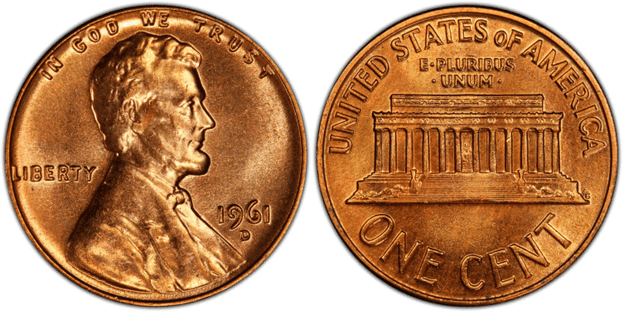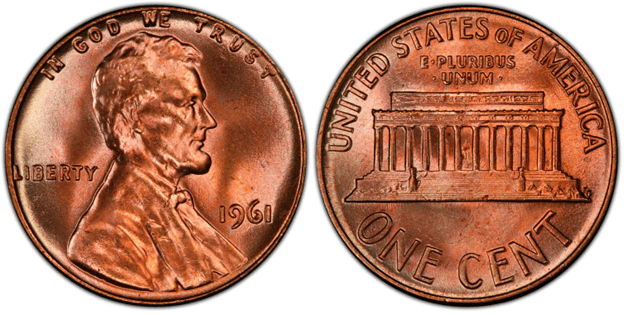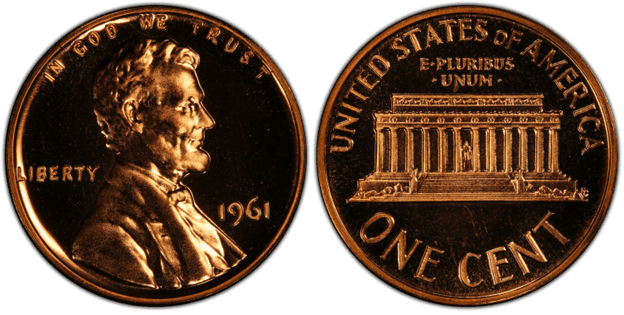What Is the 1961 Lincoln Penny Made Of?
The 1961 Lincoln penny, also known as the Lincoln cent, is made of 95% copper and 5% tin and zinc. Today, the composition is different. The Lincoln penny is now made of 97.5% zinc and 2.5% copper.
Here are some of the quick specifications of the Lincoln penny made in 1961:
- Value – 1 cent
- Mass – 3.11 grams
- Designer – Victor David Brenner (obverse) and Frank Gasparro (reverse)
- Edge – plain
- Diameter – 19 mm
- Total mintage – 2,509,639,944
The Lincoln penny was first struck in 1909, the same year when Abraham Lincoln would have celebrated the centennial year of his birth. At first, the reverse of the penny was stalks of wheat. Later in 1959, the Lincoln Memorial replaced the wheat image.
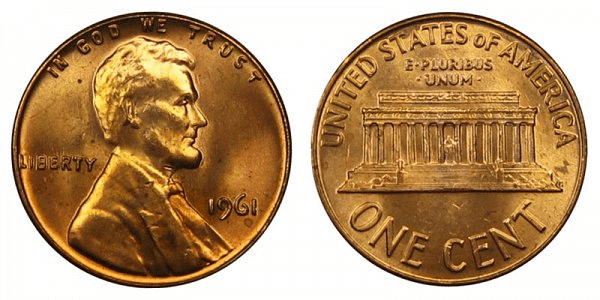
The obverse design remained essentially the same from the day the Lincoln penny was first released. Designed by Victor David Brenner, the Lincoln penny features the image of Lincoln, facing to the right. On top of him is the US motto, “IN GOD WE TRUST.” On his back is the word “LIBERTY” and in front of him is the year of minting, which is 1961. If present, the mint mark can be found just below the year.
On the reverse, you will find the front view of the Lincoln Memorial. On top, you’ll find the UNITED STATES OF AMERICA arching while below, you’ll see “ONE CENT.” You’ll also read the US motto, “E PLURIBUS UNUM,” which means “Out of many, one.”
When the Lincoln was first released, it was made of 95% copper. Due to the rising cost of copper, the US Mint was forced to use zinc instead.
1961 Lincoln Penny Varieties
The Lincoln penny in 1961 comes in different varieties. These are the 1961-P, 1961, D, and 1961-P proof. There are also some error coins that sporadically appear during the minting process.
Here are the 1961 Lincoln penny varieties that you should know:
1961 D Lincoln Penny
Year of minting: 1961
Mint Mark: D
Place of minting: Denver
Quantity produced: 1,753,266,700
Face Value: $0.01 (one cent)
Price: $0.01 to $6.00 (or more)
Mass: 3.11 grams
Edge: Plain
Designer: Victor D. Brenner (obverse) / Frank Gasparro (reverse)
Composition: 95% copper and 5% zinc
Diameter: 19.05 mm
Thickness: 1.52 mm

photo source: PCGS
The Denver Mint produced more than 1.75 billion 1961 D pennies. This is a very high mintage number, which is understandable since the penny is the smallest coin denomination in the United States. The price range of the 1961 D penny is $0.01 to $6.00.
1961 P Lincoln Penny
Year of minting: 1961
Mint Mark: None
Place of minting: Philadelphia
Quantity produced: 753,345,000
Face Value: $0.01 (one cent)
Price: $0.01 to $6.00 (or more)
Mass: 3.11 grams
Edge: Plain
Designer: Victor D. Brenner (obverse) / Frank Gasparro (reverse)
Composition: 95% copper and 5% zinc
Diameter: 19.05 mm
Thickness: 1.52 mm

photo source: PCGS
The Philadelphia Mint produced more than 753 million Lincoln pennies in 1961. It’s lower than the production number of the Denver Mint. Nevertheless, it’s still an impressive number. The price range is also the same as the 1961-D penny.
1961 Lincoln Penny (Proof)
Year of minting: 1961
Mint Mark: None
Place of minting: Philadelphia
Quantity produced: 3,028,244
Face Value: $0.01 to $8.00 (or more)
Price: $0.01 to $6.00 (or more)
Mass: 3.11 grams
Edge: Plain
Designer: Victor D. Brenner (obverse) / Frank Gasparro (reverse)
Composition: 95% copper and 5% zinc
Diameter: 19.05 mm
Thickness: 1.52 mm

photo source: PCGS
Aside from producing regular strike pennies, in 1961 the Philadelphia Mint produced proof coins as well. The proof coins are meant for collectors. Thus, you’ll notice that there are just about 3 million of this coin type made in 1961.
The proof coins were specially made so that they will showcase a more detailed, shinier, and more gorgeous appearance. To add a deeper cameo surface, the die is struck twice. Aside from that, each coin is shined individually.
List of 1961 Lincoln Penny Errors
There are billions of 1961 Lincoln pennies. As you can imagine, there’s always a chance that something will go wrong along the minting process and error coins would appear.
An error can happen during the cutting of planchet. Planchets can become too thin or too thick. It may not also be a perfect circle. Some get clipped and some get folded.
Here’s an example of a clipped planchet:
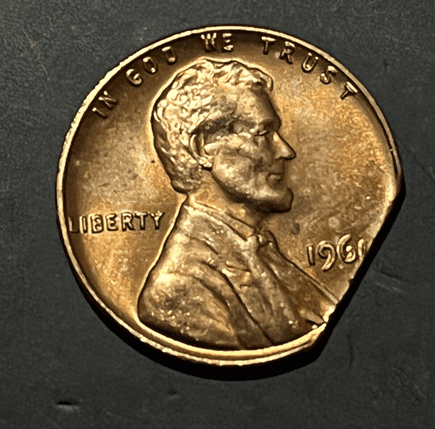
There are also times when there are contaminants that get into the coin. Thus, when the planchet was heated and produced, it cracked or separated. This is called a lamination error.
Errors can also happen during the die strikes. Double strikes may happen, which results in a doubling of the engraved elements. Here’s an example:
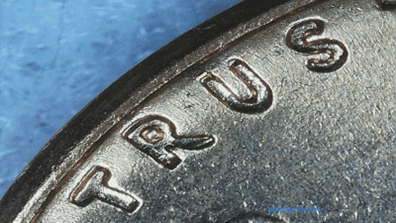
The more obvious the double strike error is, the more valuable the coin becomes.
Off-center strikes happen when the die hits the coin at the wrong angle. There can also be weak strikes that make the engraved elements blurry.
Strikethrough errors happen when a foreign material gets between the die and the planchet. When the die hits the planchet, it strikes through foreign material, which can be grease, dust, or metal clippings. The foreign material can be engraved on the planchet or it can leave a mark.
Because of the multiple-hitting action of the die, it may also break. Die-break errors may leave unintended lines on the coin.
How Much Is the 1961 Lincoln Penny Worth Today?
The 1961 Lincoln penny is worth one cent. Its melt value is $0.0240. So, if you’re just going to base the value of the 1961 Lincoln penny on its face value and melt value, you won’t get much from it.
However, there are still 1961 pennies that are worth a lot of money. Here’s a 1961 Lincoln Penny values chart:
| Coin | Condition | Grade | Mintage | Value |
| 1961 D Lincoln penny | Circulated/mint | Not graded | 1,753,266,700 | $0.01 to $6.00 |
| 1961 D Lincoln penny | Uncirculated/mint | MS-65 | 1,753,266,700 | $7 to $19 |
| 196 D Lincoln penny | Uncirculated/mint | MS-66 | 1,753,266,700 | $11 to $45 |
| 1961 D Lincoln penny | Uncirculated/mint | MS-67 | 1,753,266,700 | $106 to $1,440 |
| 1961 P Lincoln penny | Circulated/mint | Not graded | 753,345,000 | $0.01 to $6.00
|
| 1961 P Lincoln penny | Uncirculated/mint | MS-65 | 753,345,000 | $7 to $13 |
| 1961 P Lincoln penny | Uncirculated/mint | MS-66 | 753,345,000 | $25 to $40 |
| 1961 P Lincoln penny | Uncirculated/mint | MS-67 | 753,345,000 | $176 to $900 |
| 1961 Proof Lincoln penny | Circulated/proof | Not graded | 3,075,645 | $0.01 to $8.00 |
| 1961 Proof Lincoln penny | Uncirculated/proof | PR-67 | 3,075,645 | $7 to $105 |
| 1961 Proof Lincoln penny | Uncirculated/proof | PR-68 | 3,075,645 | $16 to $45 |
| 1961 Proof Lincoln penny | Uncirculated/proof | PR-69 | 3,075,645 | $45 to $132 |
As you can see, there are 1961 pennies that are more valuable. According to PCGS, the most expensive 1961 D penny they have recorded is the one sold in Heritage Auctions on June 4, 2014. It was sold for $4,406. For the 1961-P penny, the record is $5,720. Finally, for the 1961 penny proof coin, the record is $1,265.
How Does The Grading System Work?
The Sheldon Scale is used by numismatists to provide a numerical value to coins. The Sheldon Scale goes from poor (P-1) to perfect mint state (P-1) (MS-70). Coins were originally evaluated using words to reflect their condition (Good, Fair, Excellent, Etc.). Unfortunately, coin collectors and dealers had different ideas about what each of these terms represent.
Professional numismatists joined together in the 1970s and established CoinGrading standards. These numismatists now assign grades at key places on the seventy-point scale, using the most regularly utilized numeric points in conjunction with the original adjective grade. The following are the most common coin grades:
-
-
- (P-1) Poor – Indistinguishable and probably damaged; if used, must have a date and mintmark; otherwise, rather battered.
- (FR-2) Fair – Nearly smooth, but without the damage that a coin graded Poor often possesses. The coin must have enough detail to be identified.
- (G-4) Fair – Inscriptions have merged into the rims in some areas, and important elements have been mostly erased.
- (VG-8) Very Good- A little weathered, but all of the primary design elements are visible, albeit faintly. There is little if any, central detail left.
- (F-12) Good – The item is very worn, yet the wear is even, and the overall design details stand out clearly. Rims are almost completely isolated from the field.
- (VF-20) Very Fine – Moderately weathered, with some finer features still visible. The motto or all letters of LIBERTY are readable. Both sides of the coin have entire rims that are separated from the field.
- (EF-40) Extremely Fine – Gently used; all gadgets are visible, and the most important ones are bold. The finer details are bold and clear, however, light wear may be seen.
- (AU-50) Uncirculated – Slight evidence of wear on the coin’s design’s high points; may have contact marks; eye appeal should be adequate.
- (AU-58) Uncirculated Choice – Slight traces of wear, no severe contact marks, almost full mint shine, and great eye appeal.
- (MS-60) Mint State Basal – Strictly uncirculated; no indication of wear on the coin’s highest points, but an unsightly coin with reduced luster, visible contact marks, hairlines, and other flaws.
- (MS-63) Mint State Acceptable – Uncirculated, but with contact scratches and nicks, little reduced shine, but otherwise appealing appearance. The strike is weak to average.
- (MS-65) Mint State Choice – Uncirculated with great mint shine, very little contact blemishes, and exceptional eye appeal. The strike is unusually severe.
- (MS-68) Mint State Premium Quality – Uncirculated with superb luster, no obvious contact marks to the naked eye, and exceptional eye appeal. The strike is quick and appealing.
- (MS-69) Almost Perfect Mint State – Uncirculated with perfect brilliance, a sharp and appealing strike, and extremely good eye appeal. A near-perfect coin with minor imperfections in the planchet, strike, and contact markings (seen only under 8x magnification).
- (MS-70) Mint State Perfect – Under 8x magnification, there are no tiny imperfections discernible; the strike is crisp, and the coin is perfectly centered on a beautiful planchet. Rarely seen on a coin, this coin is bright and whole, with original luster and exceptional eye appeal.
-
Where To Buy Or Sell 1961 Lincoln Penny?
You can buy or sell a 1961 Lincoln penny online. Simply do a Google search and you should instantly get a list of websites where you can find your coin. If you want to jump into a specific website, you can try Amazon and eBay. These marketplaces allow you to both buy and sell 1961 Lincoln pennies. Just open an account and you’re ready to go.
If the Internet is not your thing or it failed to give you what you’re looking for, you can go to coin shops, antique stores, and auction houses. You can also get the help of fellow coin collectors.
FAQs
How much is a 1961 mint condition penny worth?
The price range of a 1961 penny in mint condition may range from $1 to $10. It depends on the grade of the penny. 1961 pennies with a grade that is at least MS 66 may reach up to $100 to $1000.
What year pennies are worth keeping?
Pennies with low mintage years are considered to be worth keeping. These include the 1931-S, 1933-D, 1939-D, and 1955-S.
What if my 1961 Lincoln penny has no mint mark?
A 1961 Lincoln penny with no mint mark means it was struck in the Philadelphia Mint. This mint traditionally doesn’t add mint marks on the coins they produce.
Is my 1961 penny worth $8,500?
The best way to determine the value of your penny is to get it examined by a qualified coin appraiser. However, for starters, you can initially check your 1961 penny. It should be in the best condition possible. There should be no visible blemishes, scratches, or discolorations.

